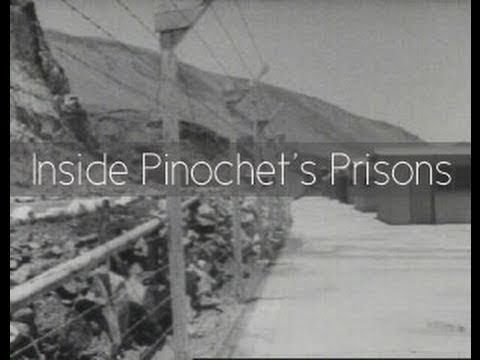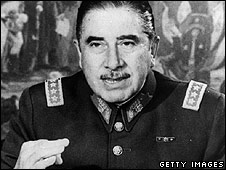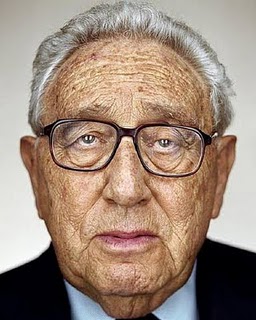Alex Constantine - June 23, 2010
By J. Patrice McSherry
Crimes of War | July 6, 2001
 According to recently de-classified files, the U.S. aided and facilitated Condor operations as a matter of secret but routine policy.
According to recently de-classified files, the U.S. aided and facilitated Condor operations as a matter of secret but routine policy.
In mid-April, 2001, Argentine judge Rodolfo Canicoba issued path-breaking international arrest warrants for two former high-ranking functionaries of the military regimes of Chile and Paraguay. These two, along with an Argentine general also summoned by the court, are accused of crimes committed within the framework of Operation Condor. Judge Canicoba presides over one of several cases worldwide investigating abductions and murders linked to Condor, a shadowy Latin American military network created in the 1970s whose key members were Chile, Argentina, Uruguay, Bolivia, Paraguay, and Brazil, later joined by Peru and Ecuador. Condor was a covert intelligence and operations system that enabled the Latin American military states to hunt down, seize, and execute political opponents across borders. Refugees fleeing military coups and repression in their own countries were "disappeared" in combined transnational operations. The militaries defied international law and traditions of political sanctuary to carry out their ferocious anticommunist crusade.
The judge's request for the detention and extradition of Manuel Contreras of Chile, former chief of the gestapo-like Directorate of National Intelligence (DINA), and former dictator Alfredo Stroessner of Paraguay, along with his summons for ex-junta leader Jorge Videla of Argentina, represents another example of the rapid advances occurring in international law and justice since the arrest of General Pinochet in 1998. In effect, the struggle against impunity is being "globalized."
As human rights organizations, families of victims, lawyers, and judges press for disclosure and accountability regarding human rights crimes committed during the Cold War, inevitable questions arise as to the role of the foremost leader of the anticommunist alliance, the United States. This article explores recent evidence linking the U.S. national security apparatus with Operation Condor. Condor took place within the broader context of inter-American counterinsurgency coordination and operations led and sponsored by the Pentagon and the CIA. U.S. training, doctrine, organizational models, technology transfers, weapons sales, and ideological attitudes profoundly shaped security forces in the region.
Recently declassified documents add weight to the thesis that U.S. forces secretly aided and facilitated Condor operations. The U.S. government considered the Latin American militaries to be allies in the Cold War, worked closely with their intelligence organizations, and promoted coordinated action and modernization of their capabilities. As shown here, U.S. executive agencies at least condoned, and sometimes actively assisted, some Condor "countersubversive" operations.
What was Operation Condor?
In the 1960s and 1970s, populist, nationalist, and socialist movements emerged throughout the class-stratified nations of Latin America, challenging the entrenched privileges of local oligarchies as well as U.S. political and economic interests. In this context, U.S. national security strategists (who feared "another Cuba") and their Latin American counterparts began to regard large sectors of these societies as potentially or actually subversive. Cold War NationalSecurity Doctrine--a politicized doctrine of internal war and counterrevolution that targeted "internal enemies"--incorporated U.S. and French counterinsurgency concepts and anticommunist ideology. The doctrine gave the militaries a messianic mission: to remake their states and societies and eliminate "subversion." Political and social conflict was viewed through the lens of countersubversive war; the counterinsurgents believed that world communism had infiltrated their societies. During these years, militaries in country after country ousted civilian governments in a series of coups--even in such long-standing democracies as Chile and Uruguay--and installed repressive regimes. The "anticommunist crusade" became a crusade against the principles and institutions of democracy and against progressive and liberal as well as revolutionary forces, and the national security states institutionalized state terrorism.
Operation Condor allowed the Latin American militaries to put into practice a key strategic concept of national security doctrine: hemispheric defense defined by ideological frontiers. The more limited concept of territorial defense was superseded. To the U.S. national security apparatus--which fostered the new continent-wide security doctrine in its training centers, such as the Army School of the Americas in Panama--and most of the Latin American militaries, the Cold War represented World War III, the war of ideologies. Security forces in Latin America classified and targeted persons on the basis of their political ideas rather than illegal acts. The regimes hunted down dissidents and leftists, union and peasant leaders, priests and nuns, intellectuals, students and teachers--not only guerrillas (who, under international law, are also entitled to due process).
Condor specialized in targeted abductions, disappearances, interrogations/torture, and transfers of persons across borders. According to a declassified 1976 FBI report, Condor had several levels. The first was mutual cooperation among military intelligence services, including coordination of political surveillance and exchange of intelligence information. The second was organized cross-border operations to detain/disappear dissidents. The third and most secret, "Phase III," was the formation of special teams of assassins from member countries to travel anywhere in the world to carry out assassinations of "subversive enemies." Phase III was aimed at political leaders especially feared for their potential to mobilize world opinion or organize broad opposition to the military states.
Victims of Condor's Phase III, conducted during the mid-1970s, included Chilean Orlando Letelier--foreign minister under President Salvador Allende and a fierce foe of the Pinochet regime--and his American colleague Ronni Moffitt, in Washington D.C., and Chilean Christian Democrat leader Bernardo Leighton and his wife, in Rome. Condor assassinations in Buenos Aires were carried out against General Carlos Prats, former Commander-in-Chief of the Chilean army; nationalist ex-president of Bolivia Juan Jose Torres; two Uruguayan legislators known for their opposition to the Uruguayan military regime, Zelmar Michelini and Hector Gutierrez Ruiz. In the first two cases, DINA assassination teams "contracted" local terrorist and fascist organizations to assist in carrying out the crimes. A U.S.-born DINA assassin--expatriate Michael Townley--admitted his role in the Prats, Letelier-Moffitt, and Leighton crimes. Clearly, Operation Condor was an organized system of state terror with a transnational reach.
According to a declassified Defense Intelligence Agency (DIA) report from 1976, Condor used multinational commando teams made up of military and paramilitary operatives who carried out combined cross-border operations, and testimony from survivors of such operations confirms this. Condor also employed a telecommunications system (Condortel) to coordinate its intelligence, planning, and operations against political opponents. An Argentine military source told a U.S. Embassy contact in 1976 that the CIA had played a key role in setting up the computerized links among the intelligence and operations units of the six Condor states.
Declassified U.S. documents make clear that U.S. security officers saw Condor as a legitimate "counterterror" organization. One 1976 DIA report stated, for example, that one Condor team was "structured much like a U.S. Special Forces Team," and described Condor's "joint counterinsurgency operations" to "eliminate Marxist terrorist activities." This report noted that Latin American military officers bragged about Condor to their U.S. counterparts. Numerous other CIA, DIA, and State Department documents referred to Condor as a counterterror or countersubversive organization and some described its assassination capability in a matter-of-fact manner. In 1978, for example, the CIA wrote that by July 1976 "the Agency was receiving reports that Condor planned to engage in `executive action' outside the territory of member countries." In fact, the documentary evidence shows that the CIA was fully aware of such capabilities and operations years earlier.
Known Cases of U.S. Collaboration with Condor
A key case illuminating U.S. involvement in Condor countersubversive operations was that of Chilean Jorge Isaac Fuentes Alarc=F3n, who was seized by Paraguayan police as he crossed the border from Argentina to Paraguay in May 1975. Fuentes, a sociologist, was suspected of being a courier for a Chilean leftist organization. Chile's Truth and Reconciliation Commission later learned that the capture of Fuentes was a cooperative effort by Argentine intelligence services, personnel of the U.S. Embassy in Buenos Aires, and Paraguayan police. Fuentes was transferred to Chilean police, who brought him to Villa Grimaldi, a notorious DINA detention center in Santiago. He was last seen there, savagely tortured.
Recently declassified U.S. documents include a letter from the U.S. Embassy in Buenos Aires (written by FBI official Robert Scherrer) informing the Chilean military that Fuentes had been captured. Additionally, Scherrer provided the names and addresses of three individuals residing in the United States whom Fuentes named during his interrogation, and told his counterparts in the Pinochet regime that the FBI was conducting investigations of the three. This letter, among others, confirms that U.S. officials and agencies were cooperating with the military dictatorships and acting as a link in the Condor chain. Perhaps most striking is that this coordination was routine (if secret), standard operating procedure within U.S. policy.
Two of the most explosive discoveries about U.S. links to Condor have emerged in the past few months. First is a 1978 Roger Channel cable from Robert White, then Ambassador to Paraguay, to the Secretary of State, discovered by this researcher in February 2001. This declassified State Department document links Operation Condor to the former U.S. military headquarters in the Panama Canal Zone.
In the cable, White reported a meeting with Paraguayan armed forces chief General Alejandro Fretes Davalos. Fretes identified the Panama Canal Zone base of the U.S. military as the site of a secure transnational communications center for Condor. According to Fretes Davalos, intelligence chiefs from Brazil, Argentina, Chile, Bolivia, Paraguay and Uruguay used "an encrypted system within the U.S. telecommunications net[work]," which covered all of Latin America, to "coordinate intelligence information." In the cable, White drew the connection to Operation Condor and questioned whether the arrangement was in the U.S. interest--but he never received a response.
The Panama base housed the headquarters of the U.S. Southern Command (SOUTHCOM), the U.S. Special Forces, and the Army School of the Americas (SOA), among other facilities, during most of the Cold War. Tens of thousands of Latin American officers were trained at the SOA, which used the infamous torture manuals released by the Pentagon and the CIA in the mid-1990s. Latin American officers trained in Panama have confirmed that the base was the center of the hemispheric anticommunist alliance. One military graduate of the School said, "The school was always a front for other special operations, covert operations." Another officer, an Argentine navy man whose unit was organized into kidnap commandos ("task forces") in 1972, said the repression was part of "a plan that responded to the Doctrine of National Security that had as a base the School of the Americas, directed by the Pentagon in Panama." A Uruguayan officer who worked with the CIA in the 1970s, said that the CIA not only knew of Condor operations, but also supervised them.
The second astonishing piece of recently-released information is the admission by the CIA itself in September 2000 that DINA chief Manuel Contreras was a CIA asset between 1974 and 1977, and that he received an unspecified payment for his services. During these same years Contreras was known as "Condor One," the leading organizer and proponent of Operation Condor. The CIA never divulged this information in 1978, when a Federal Grand Jury indicted Contreras for his role in the Letelier-Moffitt assassinations. Contreras was sentenced to a prison term in Chile for this crime, and convicted in absentia in Italy for the Leighton attack. The CIA claims that it did not ask Contreras about Condor until after the assassinations of Letelier and Moffitt in September 1976. This assertion is hardly credible, less so when one considers that the CIA was privy to earlier assassination plans by Condor. Moreover, the CIA helped organize and train the DINA in 1974, and retained Contreras as an asset for a year after the Letelier/Moffitt assassinations. The CIA destroyed its file on Contreras in 1991.
Michael Townley's relationship to the CIA is also murky. Townley turned state's evidence in the Letelier/Moffitt assassination trial, served a short sentence, and then entered the Witness Protection Program. In Chile, Townley had said that he was a CIA operative, and so did the attorney who defended the accused Cuban exiles in the Letelier/Moffitt assassination trial in the United States. In fact, declassified documents show that Townley was interviewed by CIA recruiters in November 1970 and was judged to be "of operational interest as a possible [phrase excised] of the Directorate of Operations in 1971." The memo carefully states, however, that the "Office of Security file does not reflect that Mr. Townley was ever actually used by the Agency." A separate affidavit states that "in February 1971, the Directorate of Operations requested preliminary security approval to use Mr. Townley in an operational capacity." Townley had close ties to the U.S. Embassy and to high-ranking Foreign Service officers, who knew of his ties to the fascist anti-Allende paramilitary group Patria y Libertad. The question that must be asked is whether Townley and Contreras were acting independently, or as CIA agents in Condor planning and operations.
By Way of Conclusion
Although the documentary record is still fragmentary and many sources continue to be classified, increasingly weighty evidence suggests that the U.S. national security apparatus sponsored and supported Condor operations. The new evidence reopens important ethical, legal, and policy issues stemming from the Cold War era. In fragile Latin American democracies today, civilian governments are still struggling to deal with the legacies of state terror and to control their still-powerful military-security organizations, while families are still trying to learn what happened to their disappeared loved ones.
For U.S. citizens, the new documentation provokes troubling questions about the country’s central role in financing, training, and collaborating with institutions that carried out torture, assassination, and coups in the name of national security. During the Cold War, the ends were assumed to justify the means, resulting in appalling abuses that violated the human rights and fundamental freedoms the U.S. government publicly espoused.
A process of truth and accountability is needed in this country to address the U.S. role in Latin American repression, as a number of lawyers and human rights activists have advocated. Moreover, U.S. officials should unequivocally reject security doctrines that rationalize violations of human rights as legitimate means to any end.
--------------------------------------------------------------------------------
J. Patrice McSherry is Associate Professor of Political Science at Long Island University and author of Incomplete Transition: Military Power and Democracy in Argentina (New York: St. Martin's Press, 1997) and numerous articles on Condor and the Latin American military. She began studying Condor in the early 1990s and has conducted research in Paraguay, Chile, Argentina, and the United States.







See articles on the specific methods of the mass murder operations of condor and phoenix in Z magazine around January 2007. It was a shame to see how white activists had not included his name or work in their search archives. Lyle Courtsal http://www.3mpub.com
The NAFTA/cafta trade deals are essential components of the democracy to
dictatorship transitions that includes as part of their recipes for disaster, the
elimination of 1/3rd of their people. Not the rich proto-nazi ones, I’ll bet It is these
deals that are making many national situations practically unsurvivable and
are driving survival immigration. The rightwingers of the US only seem capable
of protecting unborn children, not ones already here.
Requiem for a Woman’s Soul is a great book on the kidnapping, torture, interrogation, and drowning murder of this student couple doing healthcare outreach
in slums down south america. The persistence of the delusional false accusations port raying them as communist operators and enemies of the state was an education in in delusional mss psychopathic institutional behavior. Scary. Lethal,
unimaginable and don’t. They really are sick, but its no excuse.
Requiem for a Woman’s Soul is by Omar Rivabella.